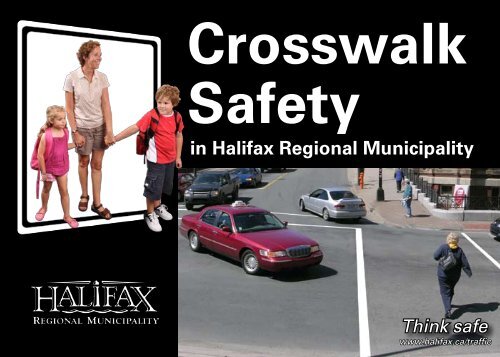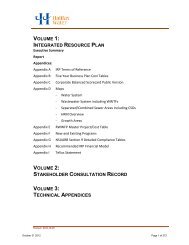Crosswalk Safety - Halifax Regional Municipality
Crosswalk Safety - Halifax Regional Municipality
Crosswalk Safety - Halifax Regional Municipality
You also want an ePaper? Increase the reach of your titles
YUMPU automatically turns print PDFs into web optimized ePapers that Google loves.
<strong>Crosswalk</strong><br />
<strong>Safety</strong><br />
in <strong>Halifax</strong> <strong>Regional</strong> <strong>Municipality</strong><br />
Think safe<br />
www.halifax.ca/traffic
Remember: It is the<br />
responsibility of every person<br />
on the road to use caution,<br />
obey traffic controls and<br />
THINK SAFE!<br />
Drivers and pedestrians share<br />
the responsibility of crosswalk<br />
safety<br />
<strong>Crosswalk</strong> <strong>Safety</strong> -<br />
The Basics<br />
1. A crosswalk exists at EVERY intersection<br />
whether it is painted or not.<br />
2. Drivers MUST yield the right of way to<br />
pedestrians who are lawfully within a<br />
crosswalk.
3. Pedestrians should always make the intent to<br />
cross the street known and NEVER enter<br />
the crosswalk when a vehicle has already<br />
entered the intersection. Pedestrians may have<br />
the right of way at a crosswalk, but approaching<br />
vehicles need to be given enough time to stop.<br />
ALWAYS stop, look and listen to ensure vehicles<br />
are going to stop before stepping into the street.<br />
4. Pedestrians crossing the street at any location<br />
other than a crosswalk MUST yield the right of<br />
way to vehicles on the road.<br />
5. If a pedestrian signal has a push-button, it<br />
should always be pushed before entering the<br />
crosswalk.<br />
6. Drivers must avoid distractions such as cell<br />
phones and hand-held devices when driving.<br />
7. It is illegal to pass a vehicle that has stopped<br />
at a crosswalk to allow a pedestrian to cross.<br />
ALWAYS obey the speed limit and look out for<br />
pedestrians.
8. It is an offence to park a vehicle within<br />
5 metres of a crosswalk. Doing so<br />
obstructs the visibility of crossing<br />
pedestrians and drivers approaching the<br />
crosswalk.<br />
Did you know?<br />
Including reaction time and braking distance:<br />
• A vehicle travelling at 50 km/hr takes more<br />
than 60 metres to stop safely (approximately<br />
12 car lengths).<br />
• At 80 kn/hr, safe stopping distance<br />
increases to 140 metres (more than 1.5<br />
times the length of a football field).<br />
• At 100 km/hr it can take more than 200<br />
metres to come to a safe stop (approximately<br />
40 car lengths).<br />
• In wet or slippery conditions, stopping<br />
distances can be 2 to 10 times greater<br />
than on dry pavement.
Types of <strong>Crosswalk</strong>s<br />
Unmarked <strong>Crosswalk</strong>s – Provincial legislation<br />
indicates that there is a legal crosswalk at every<br />
intersection, regardless of whether it is marked<br />
with paint or signs. Pedestrians still have the right<br />
of way when lawfully within these crosswalks.<br />
Marked <strong>Crosswalk</strong>s – Within HRM, marked<br />
crosswalks consist of two white lines painted<br />
across the road along with four ground mounted<br />
pedestrian crosswalk signs (two facing each<br />
direction). All marked crosswalks are re-painted<br />
every year.
How does HRM determine where to install a<br />
marked crosswalk?<br />
HRM uses criteria set out by the<br />
Transportation Association of Canada which<br />
state that a crosswalk should only be marked if<br />
it meets the following:<br />
P Pedestrian safety is not compromised<br />
(by restricted visibility for both pedestrian<br />
and driver or unusual conditions)<br />
P There is no other marked crosswalk<br />
within 200 metres<br />
P There are over 20 pedestrian crossings<br />
per hour in at least one hour of the day<br />
P Vehicle volume results in fewer than<br />
120 pedestrian crossing opportunities<br />
per hour during peak traffic times
Overhead Illuminated <strong>Crosswalk</strong> Signs – These<br />
crosswalk signs may be installed at existing<br />
marked crosswalk locations where there is:<br />
P Insufficient illumination<br />
P High vehicle speed<br />
P Limited crosswalk visibility<br />
On multi-lane roadways, the overhead illuminated<br />
crosswalk sign may be equipped with flashing<br />
amber lights that are activated by a push-button.<br />
Where these push-button beacons are present,<br />
a pedestrian is required to push the button to<br />
activate the lights before stepping into the street.<br />
Pedestrian Half Signals – A half signal is traffic<br />
control device that stops traffic on a major street<br />
so pedestrians may cross. The vehicle signal<br />
display only faces the major street, while the side<br />
streets are controlled by stop signs. Side street<br />
traffic must yield to both the major street traffic<br />
and the pedestrians.
Pedestrian Traffic Signals<br />
Pedestrian traffic signals are used at<br />
intersections where it is necessary to control<br />
the sequence of time given to pedestrian and<br />
vehicle traffic. Standard pedestrian signals use<br />
the following displays:<br />
Steady Walk Symbol<br />
The pedestrian has the right of way to cross.<br />
Always check for oncoming or turning<br />
vehicles and then proceed across the<br />
intersection.<br />
Flashing Don’t Walk Symbol<br />
The pedestrian still has the right of way if<br />
already in the crosswalk when the symbol<br />
comes on. If you are in the crosswalk, continue<br />
to cross, there will be enough time to complete<br />
the crossing. If you are not already in the<br />
crosswalk when the symbol appears DO NOT<br />
ENTER THE CROSSWALK.
Steady Don’t Walk Symbol<br />
Pedestrians should not be in the<br />
crosswalk. DO NOT ENTER THE<br />
CROSSWALK when this symbol<br />
is displayed.<br />
Many intersections with pedestrian<br />
traffic signals have push buttons. At these<br />
locations, pedestrians should always push the<br />
button. If not, the walk symbol may not appear or<br />
the crossing time may be too short.<br />
Accessible Pedestrian Signals (APS)<br />
Accessible pedestrian signals are devices<br />
added to locations with pedestrian traffic<br />
signals in order to allow people with vision<br />
loss to use the Walk and Don’t Walk signals.<br />
These devices provide sounds to indicate when it<br />
is safe to cross (a ‘coo coo’ sound for north/south<br />
crossings and the ‘Canadian Melody’ for east/west<br />
crossings).These signals may be used at locations<br />
where the crossing is considered to be complex<br />
or near public facilities such as hospitals, libraries,
schools or in the downtown cores. The sounds<br />
provided by these devices are important to<br />
those with vision loss in order to help orient<br />
them and make a safe crossing.<br />
Pedestrian Countdown Signals (PCS)<br />
Pedestrian countdown signals are used in<br />
conjunction with conventional pedestrian<br />
signals at locations with long crossings (greater<br />
than 14 metres). The countdown timer comes<br />
on with the Flashing Don’t Walk<br />
symbol and counts down the amount<br />
of time remaining to cross the street<br />
before the Steady Don’t Walk symbol<br />
appears.
It’s the Law<br />
The Nova Scotia Motor Vehicle Act is the<br />
Provincial legislation that defines the rules and<br />
responsibilities of all road users. These rules<br />
apply to all vehicles (including bicycles) as well<br />
as pedestrians when using public roads. The<br />
Nova Scotia Motor Vehicle Act does not relieve<br />
the driver of a vehicle (including bicycles) or the<br />
pedestrian from exercising due care.<br />
If a pedestrian or driver fails to obey the rules as<br />
set out in the Motor Vehicle Act, it could result in<br />
serious fines.<br />
www.nslegislature.ca/legc/statutes/motorv.htm<br />
Pay Attention<br />
Using the road requires full concentration –<br />
whether driving, walking, cycling or running. There<br />
are many distractions (e.g. cell phones and music<br />
devices). Use caution and concentrate on the road.<br />
Lives depend on it...even your own!
Contact Information<br />
Questions and comments may be directed to:<br />
<strong>Halifax</strong> <strong>Regional</strong> Muncipality<br />
Traffic & Right of Way Services<br />
PO Box 1749<br />
<strong>Halifax</strong>, NS<br />
B3J 3A5<br />
Ph: 902-490-4000<br />
traffcom@halifax.ca<br />
www.halifax.ca/traffic

















